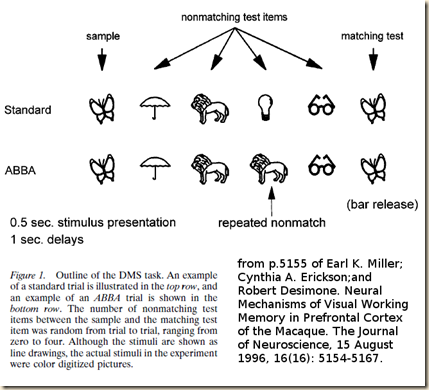by Corry Shores
[Search Blog Here. Index-tags are found on the bottom of the left column.]
[Central Entry Directory]
[Neuro-Science, entry directory]
Earl K. Miller; Cynthia A. Erickson;and Robert Desimone
Neural Mechanisms of Visual Working Memory in Prefrontal Cortex of the Macaque
Brief summary:
This research suggests that our brains retain visual information from the past by continuing neural activity in the present.
Notes:
Inserted electrodes monitored the activity of neurons in the prefrontal cortex of two monkeys’ brains.
Procedure:
(1) Monkey grabs small bar and fixates on spot of light at the screen’s center (target fixation). The monkey must maintain fixation for 300msec before the first stimulus is presented.
(2) One of the images was shown [does not specify how long].
(3) A series of other stimulus-images is given, each one for 0.5s followed by a 1s delay, after which came the next stimulus. The number of such intervening stimuli ranged from 1-4 and was randomized each time. [The 1s delay is the ‘delay-period’ referred to in the results section. See Data analysis section p.5155B.]
(4) The final image of the series was the original stimulus image. In order to receive juice, the monkey needed to release the bar within 0.9s of the stimulus’ onset.
Some trials had no repetition of intervening images, others repeated ones in an ABBA pattern of sorts.
The results show that “Many of the neurons were stimulus-selective in that they responded better to some stimuli than to others.” [p.5156]
Some neurons were most active during the fixation period. Many others were highly active during the delay period (during which the monkeys viewed a blank screen).
More than half of the PF neurons (56%, or 82/145) showed significantly higher activity during the delay intervals compared with the spontaneous firing rate. For these cells, the average baseline firing rate was 11.9 spikes/sec, and the average level of delay activity was 16.0 spikes/sec. On average, delay activity was a 42% increase over baseline firing rate (SE 5 3.3%, range 4.9–351.2%).
[p.5157, boldface mine]
Certain cells were more active than others during delays, depending on the stimuli. [5157-5159]
Earl K. Miller; Cynthia A. Erickson;and Robert Desimone. Neural Mechanisms of Visual Working Memory in Prefrontal Cortex of the Macaque. The Journal of Neuroscience, 15 August 1996, 16(16): 5154-5167.











































No comments:
Post a Comment